My reason for wanting to visit India’s southern state was to experience Kerala’s “backwaters,” an intricate network of narrow canals, lakes, and waterways that run parallel to the Arabian Sea for hundreds of miles. I have long been intrigued by the romantic notion of plying these narrow waterways via houseboat, a very popular tourist attraction in the southern state.
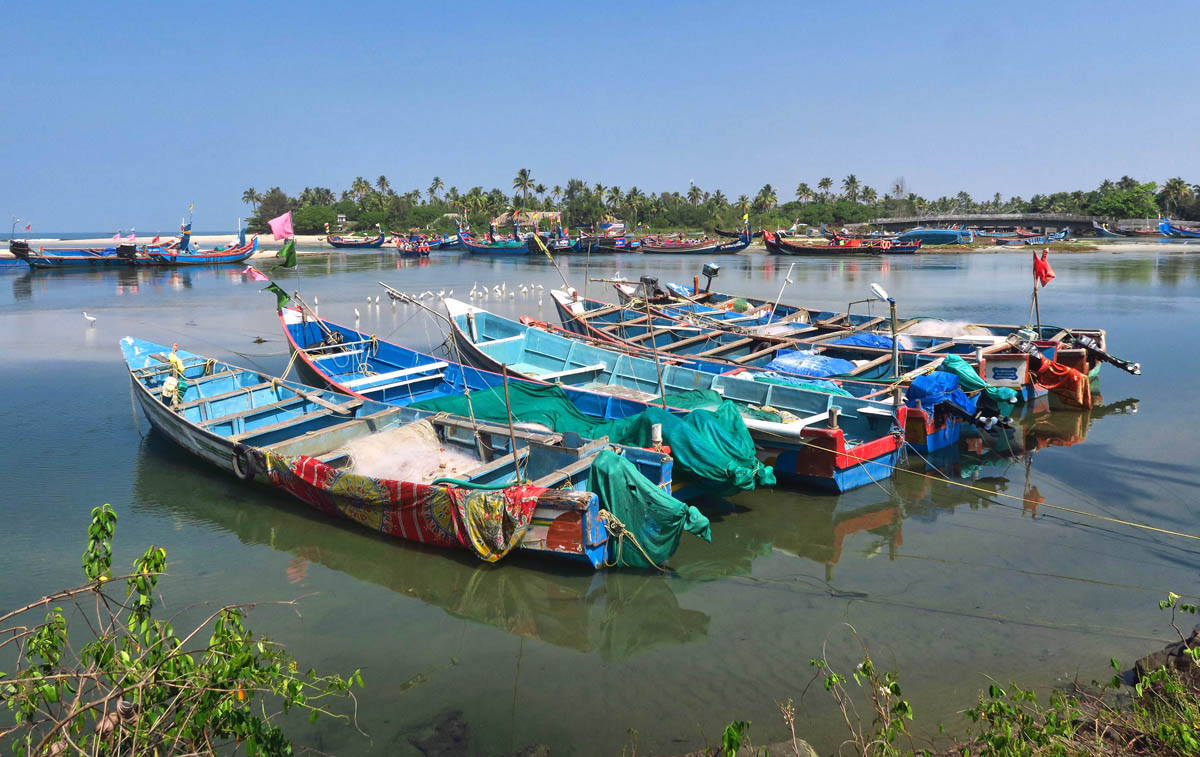
The drive along the coastal road between Cochin and Alleppey is very scenic as we pass through continuous colorful fishing villages.

Along the way, my driver tells me it’s “festival time” in Kerala, and he thinks there might be elephants at one of the Hindu temples. If so, we will stop.

A clattering cacophony of drums and cymbals can be heard as we arrive at the gates of the temple. They are rehearsing for the upcoming festival.

India is known for its Chai, a spicy hot tea made with milk. This was one of the more creative Chaiwallah stands I patronized.

On my list of “must visit” places in Alleppey was the beautiful “Alleppey Light,” built in 1862.
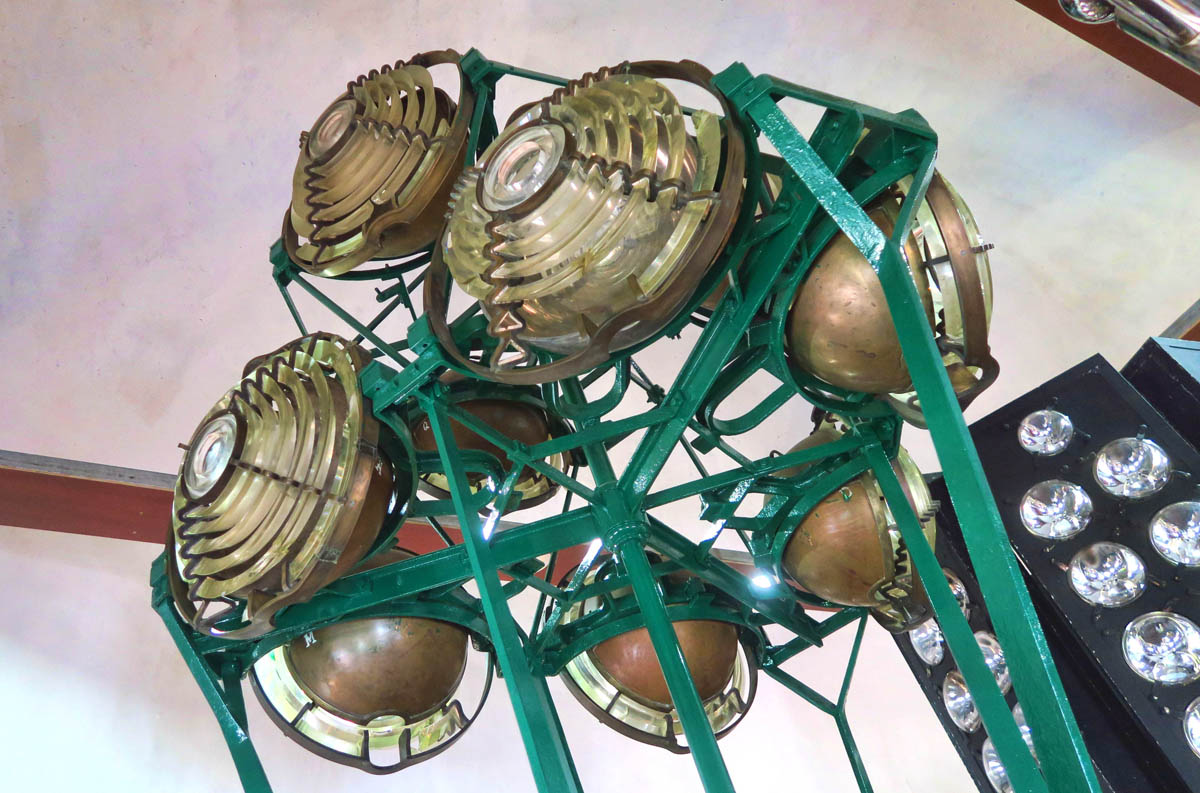
The lighthouse is open to visitors, and has a very impressive museum on the grounds that features items such as this holophote-type revolving optic with nine coconut oil wick lamps, India’s first revolving light.
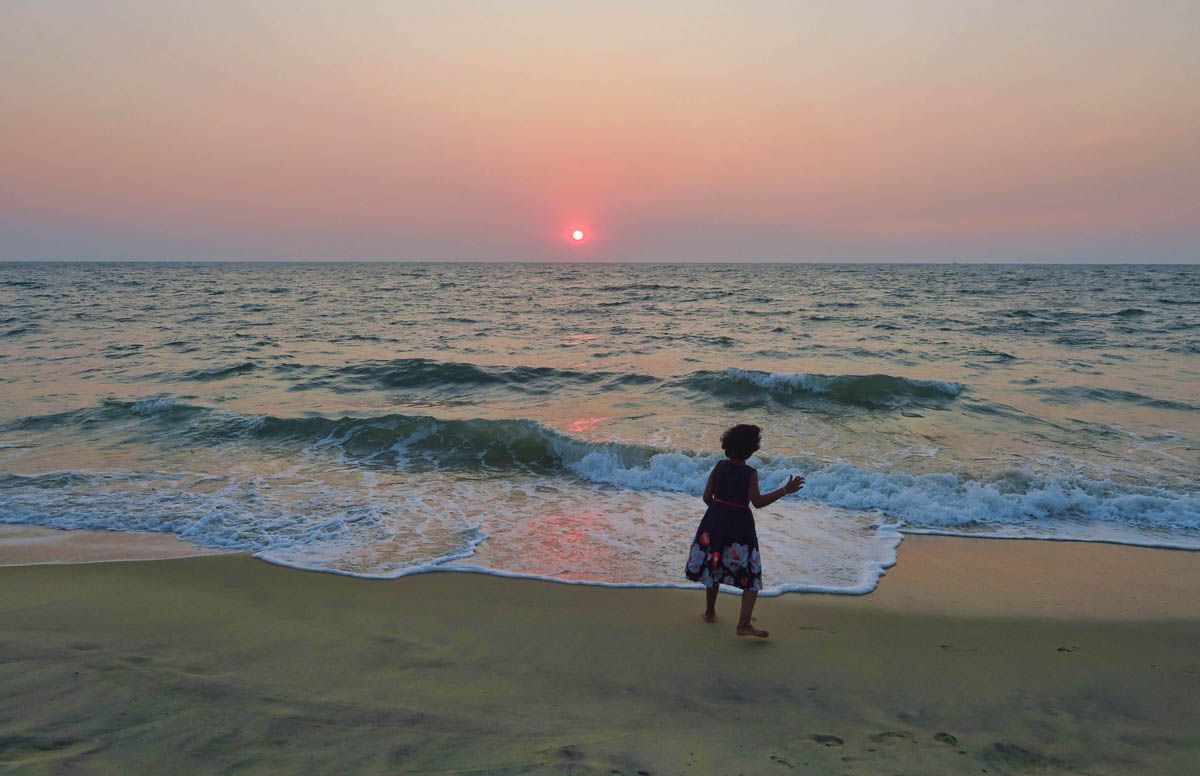
Alleppey is not only known for its canals, but also for its beautiful beach along the Arabian Sea.

The sight that I never get used to in India is people (most often women) strolling along the beach and even swimming while fully clothed.
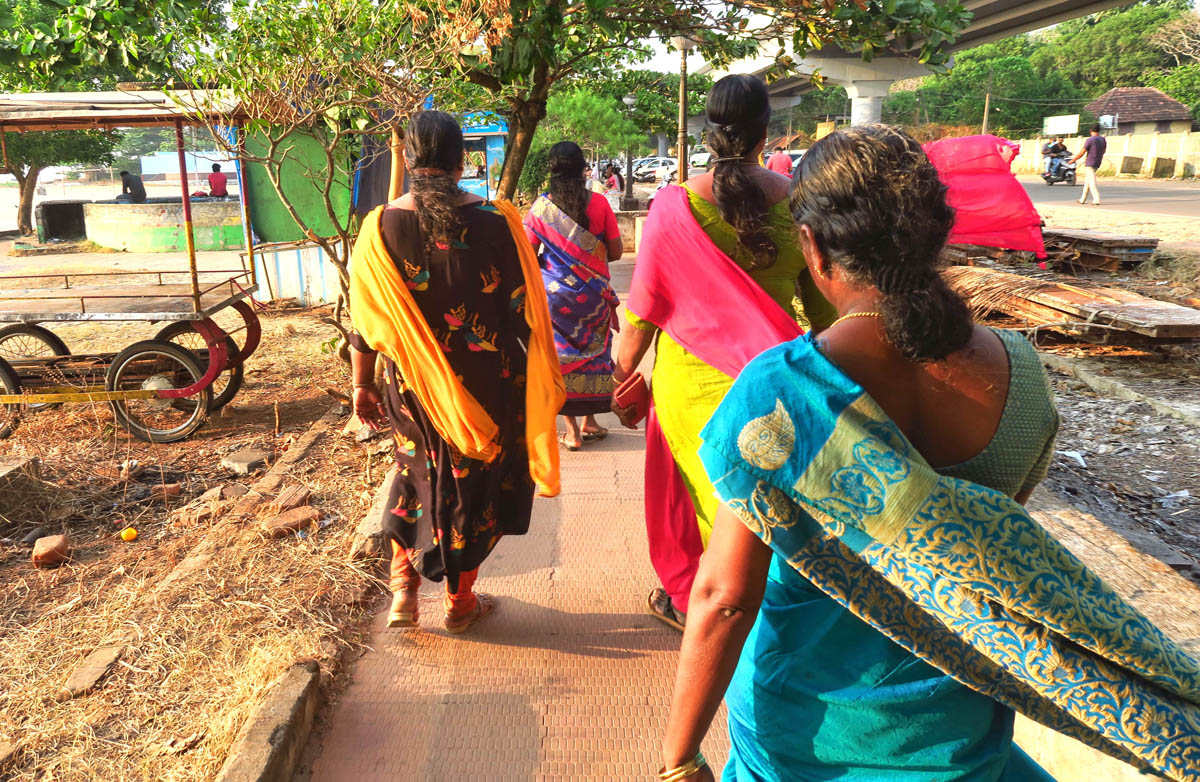
Strolling with the ladies.
Plying the backwaters of Kerala evolved into a tourist attraction in the nineties as old boats once used to carry cargo across the backwater towns became obsolete, replaced by trucks as roads into the canal villages improved. These thatched roof cargo boats known as “Kettuvalloms,” loosely translated to mean “roofed boat,” once used to carry rice and spices up the narrow waterways were gutted and fitted with air conditioned bedrooms, modern bathrooms (at least by India standards,) lounging areas, and rooftop observation decks. They run the gamut, the largest containing as many as eleven bedrooms, to the luxurious options featuring sundecks and soaking tubs.
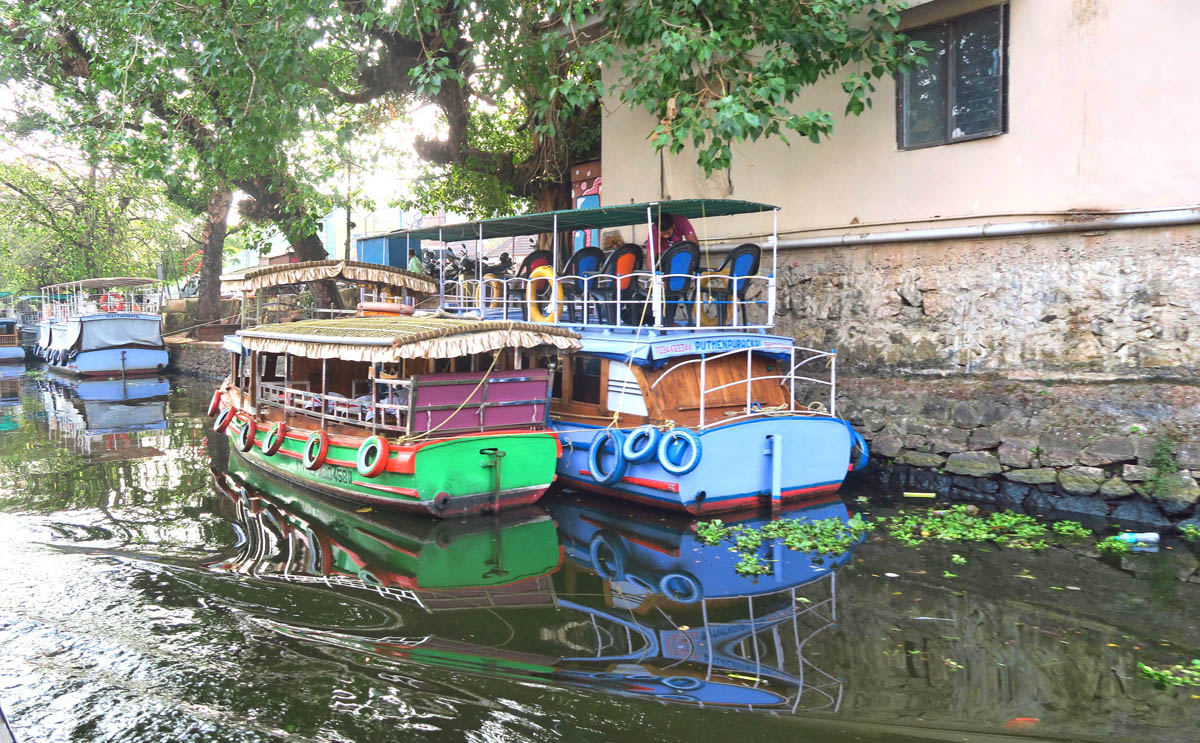
The main river running through the town of Alleppey is lined with boats of all sizes.
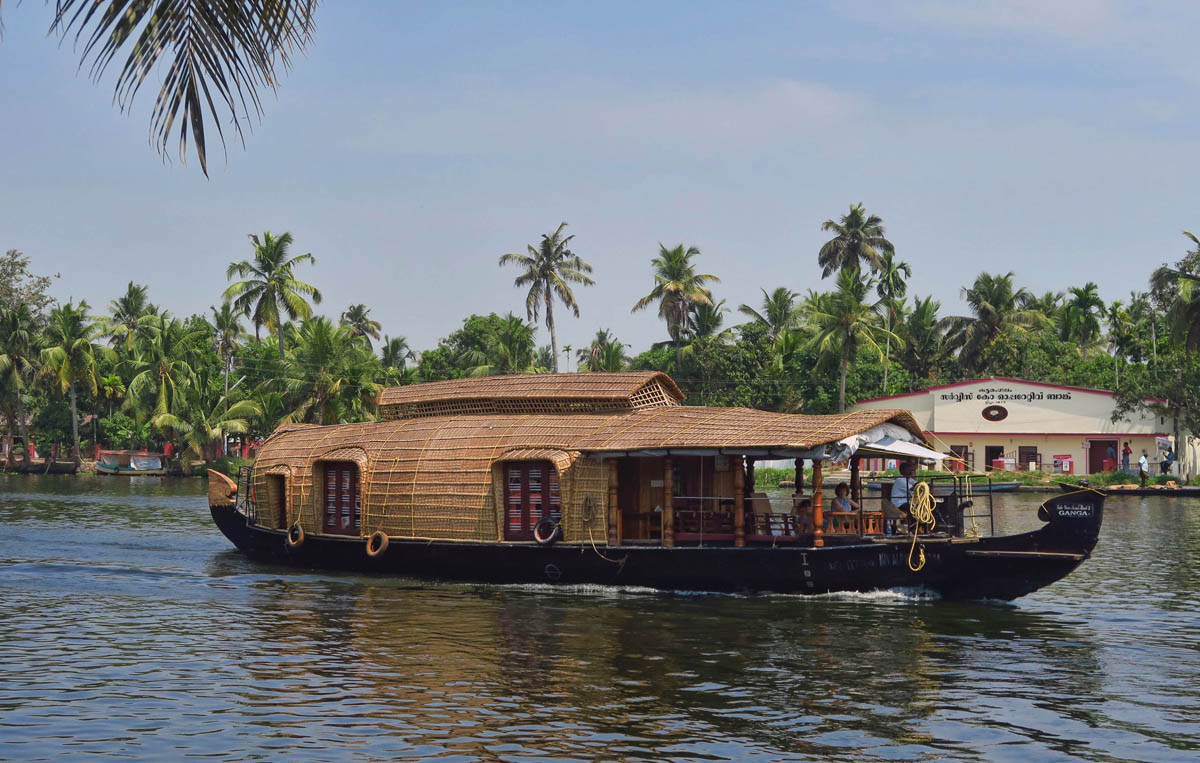
Most houseboats range from one to three bedrooms.
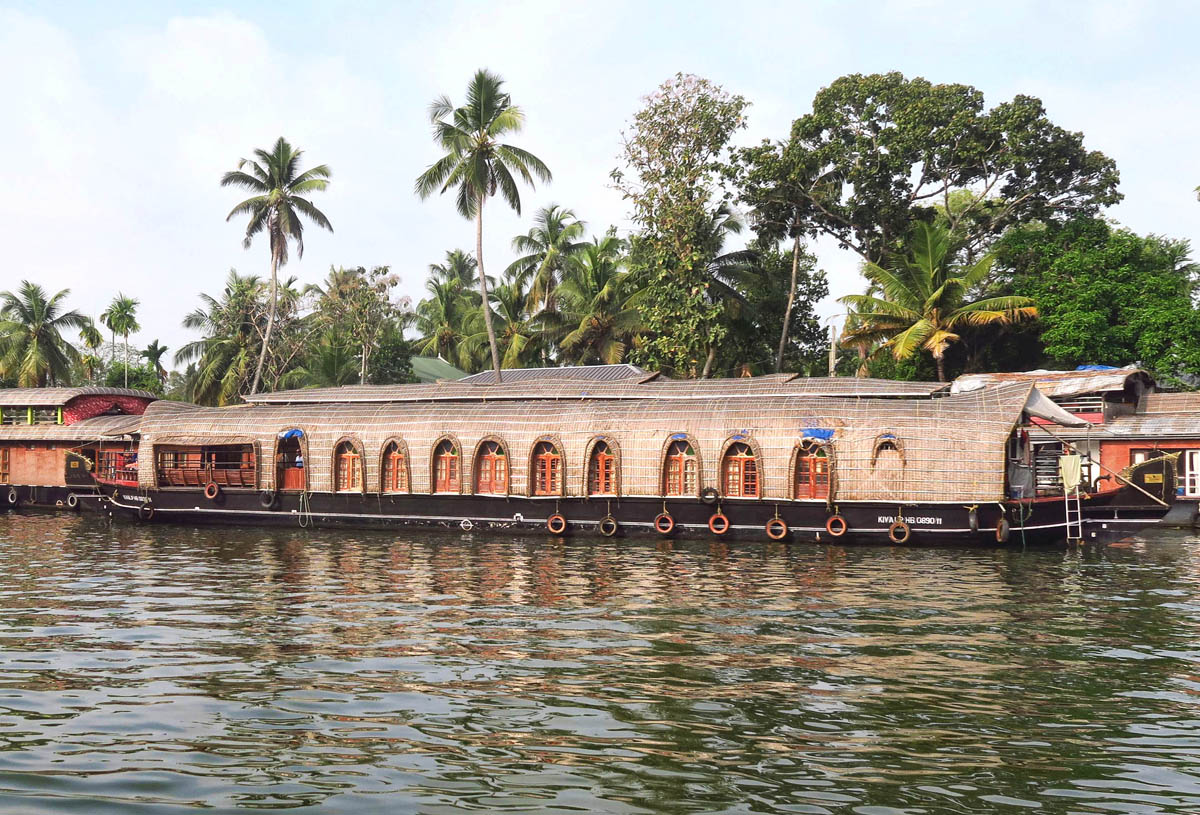
However, they can be as large as ten to eleven bedrooms!

Local ferries ply the canals as a mode of transport for the villagers.
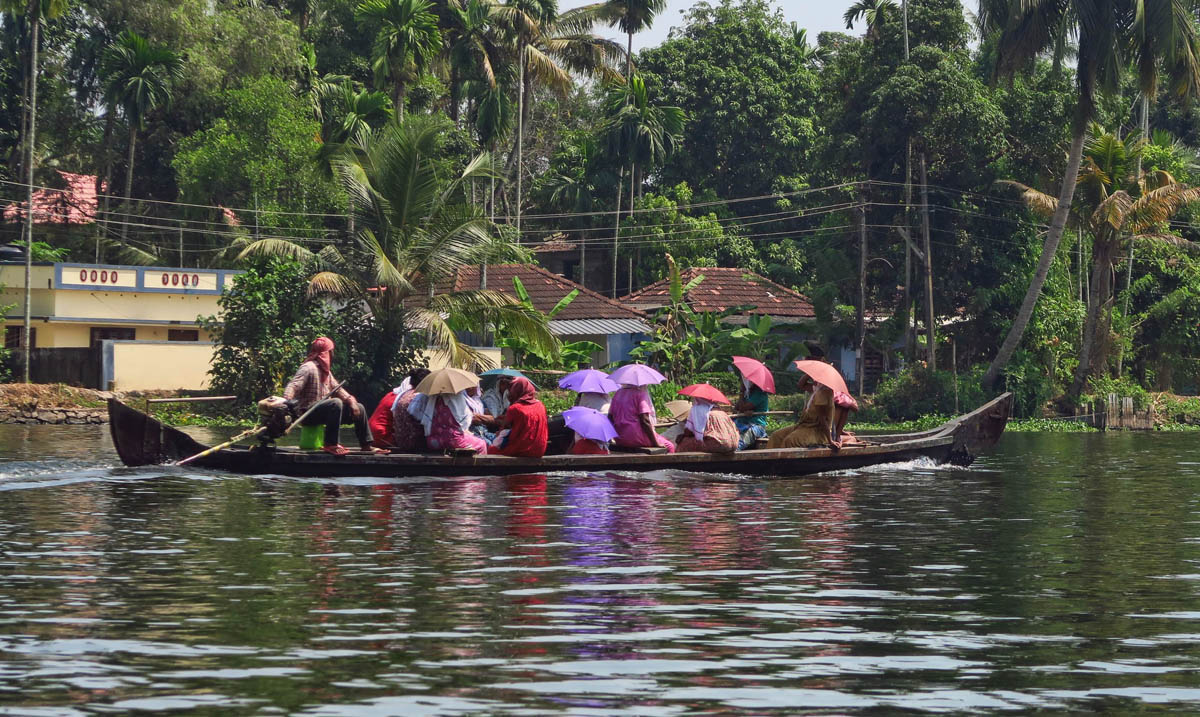
Smaller transport boats serve as “feeder boats” to the more remote areas.
While houseboating in the backwaters is prevalent along the entire coastal region of the southern state of Kerala, the hub is considered to be Alappuzha, more commonly known by its anglicized name of “Alleppey,” also known as the “Venice of the East.” I decided to wait until I got to Alleppey to book locally in order to save some money.
Only 45 miles south of Fort Kochi, I could easily reach Alleppey by car and driver, door to door for only $20, a small price to pay for not having to schlep my luggage down the long pedestrian path, cross the waterways by tuk-tuk to the train station, and beyond. Being the “shoulder season,” I was not worried about getting a space on a boat, and knew a last minute booking would be considerably cheaper.
Due to my typical lack of research, however, I hadn’t realized the larger houseboats would not get me to the more interesting, scenic areas of the backwaters. Local village life along the narrow canals centers around the water, as people come outside along the waterways to fish, do laundry, swim, and even cook. The larger Kettuvalloms, too wide to fit down the village canals, stick to the larger waterways on their way out to Vembanad, Kerala’s largest lake.
But I wanted to see more of the local daily life in the small villages, which can only be done in a “shikara,” the long, narrow wooden boats under man-power as opposed to horsepower. So I was torn in making the decision between the two options. As prolific as the houseboats are on Vembanad Lake, Alleppey is also known for its narrow wooden boats powered by an oarsman using a long paddle, which also serves as a pole to guide the boats in the shallow waters. These boats can navigate the smallest of canals, providing a more intimate glimpse into village life. It was Anoop, my kind and helpful guesthouse host at the Rain Tree Guesthouse who suggested “Why don’t you do both?” and offered to help arrange them.
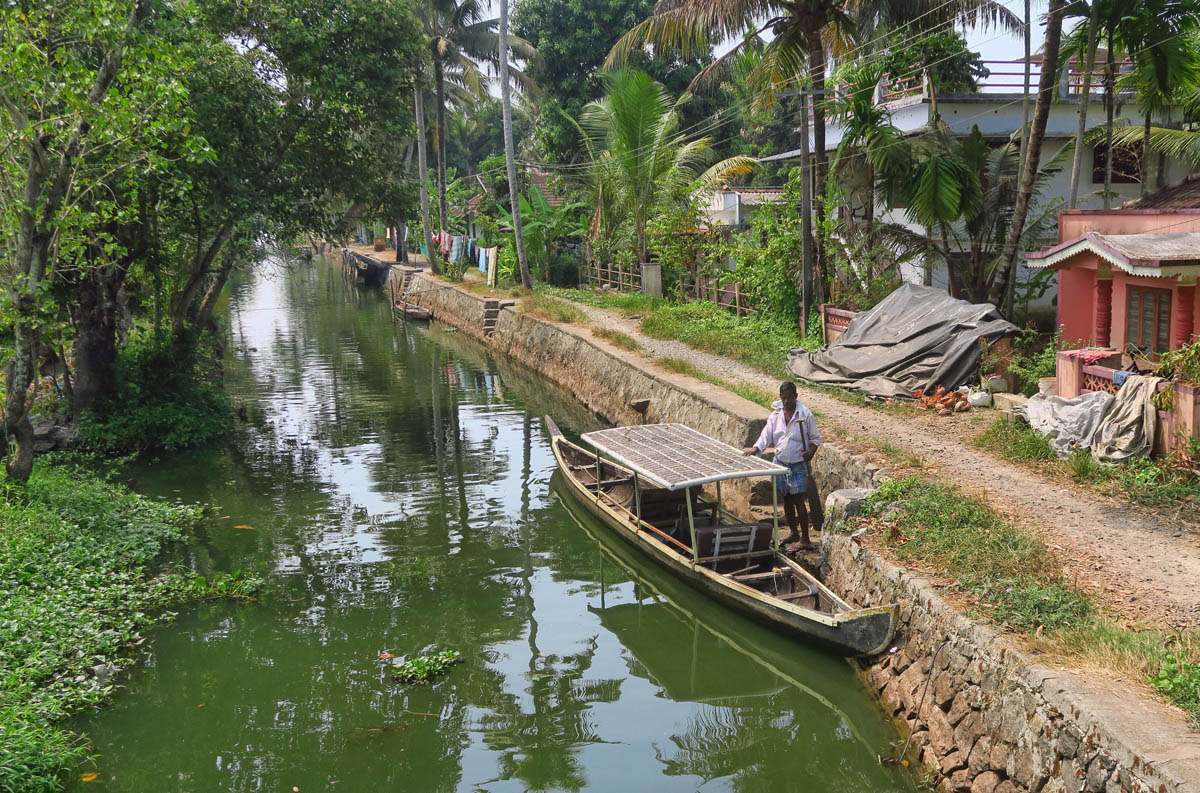
On my day trip, I go with my “host” on the local ferry to reach his village. We will be traveling through the canals on his “shikira boat” shown here.
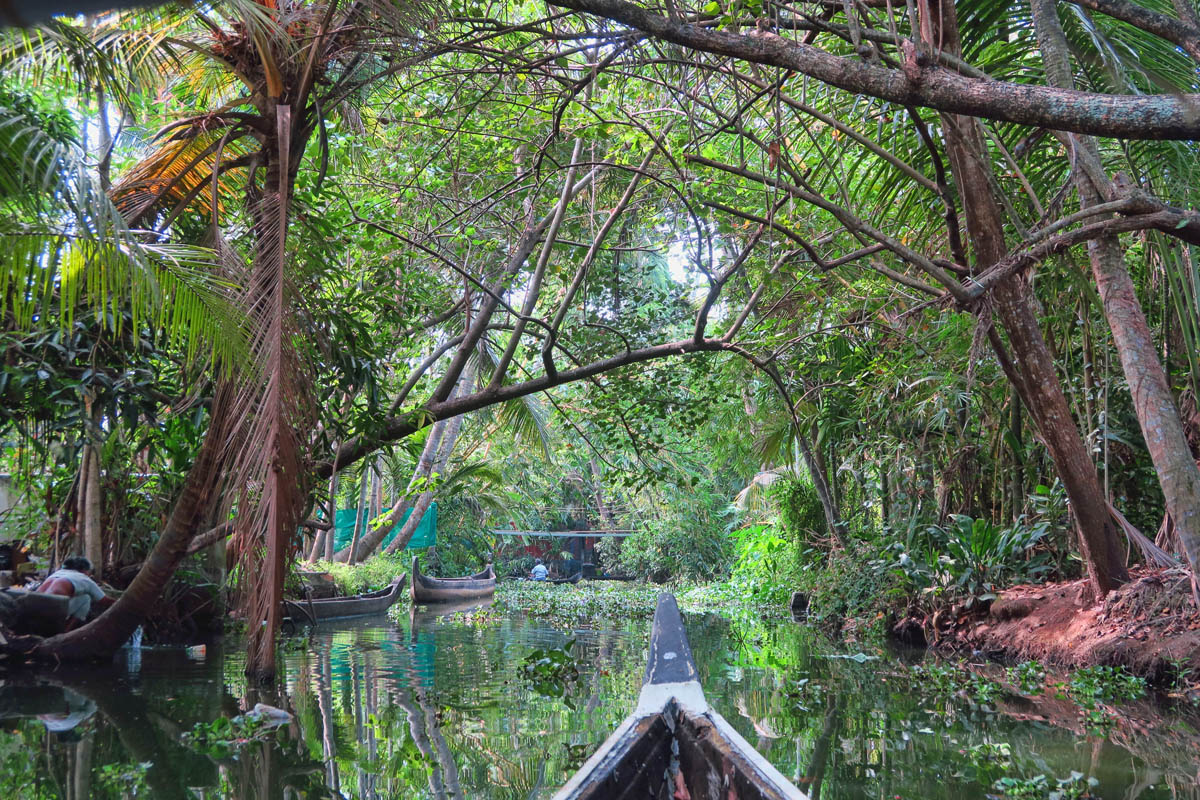
Paddling along the canals is so serene and relaxing, often with the only sounds being birds overhead, and the “drip, drip, drip” as the paddle enters and leaves the water’s surface.

Many villagers come to the waters edge to fish, do laundry, and even cook. This woman is cleaning some very small fish that she caught.
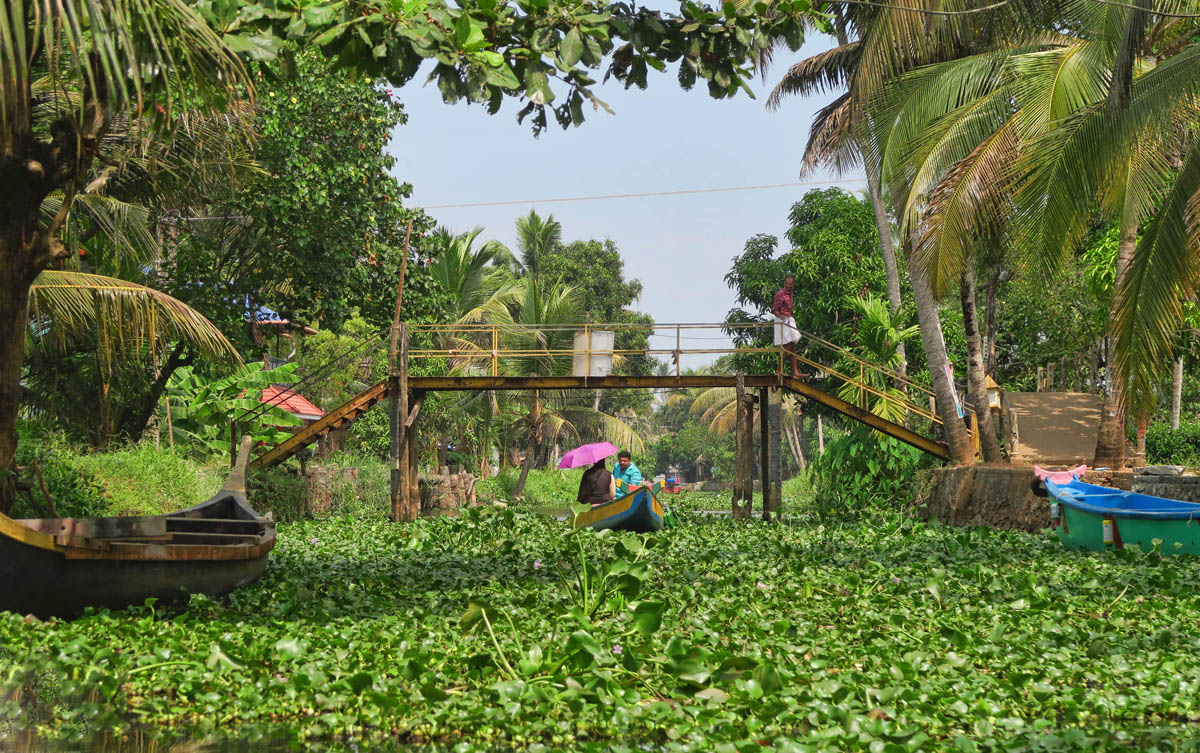
Water hyacinths are prolific along the smaller canals, causing problems for motorized boats, as well as fishlife. They are invasive, so makeshift “dams” are built from floating plastic bottles tied together to try and contain their growth.
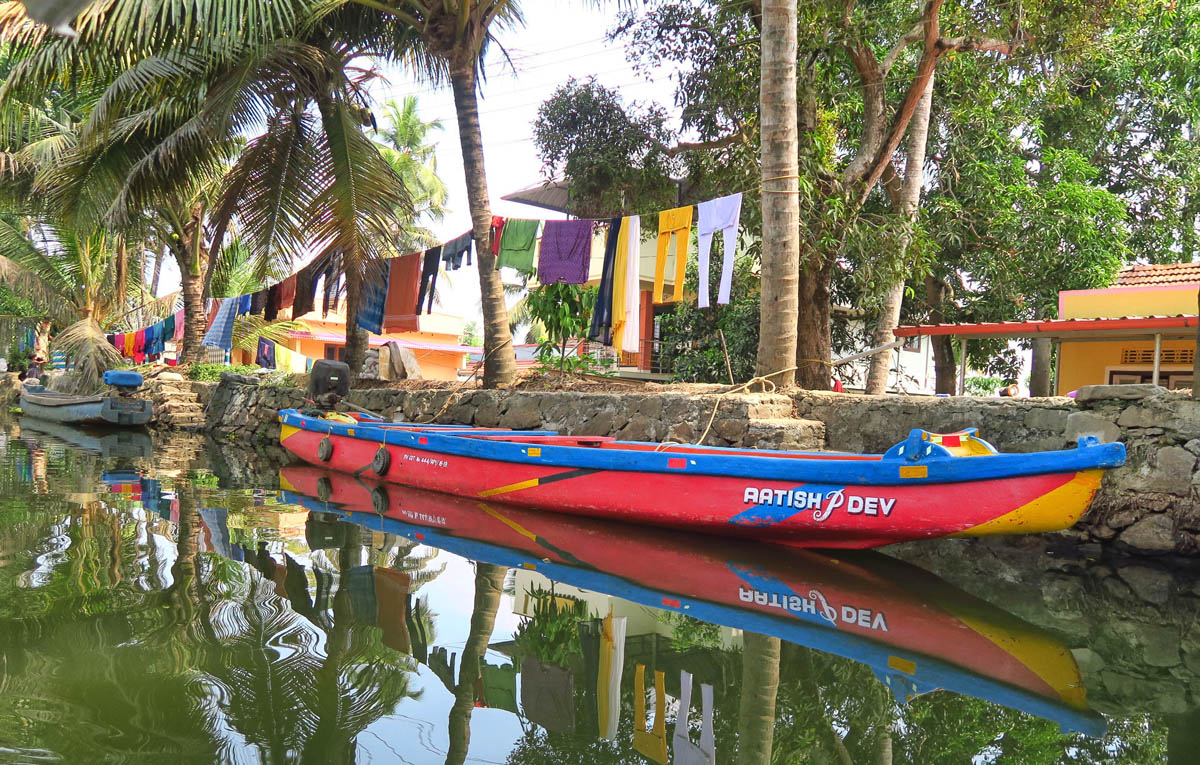
In some of the smaller villages, transport by canal is their only method to obtain supplies.
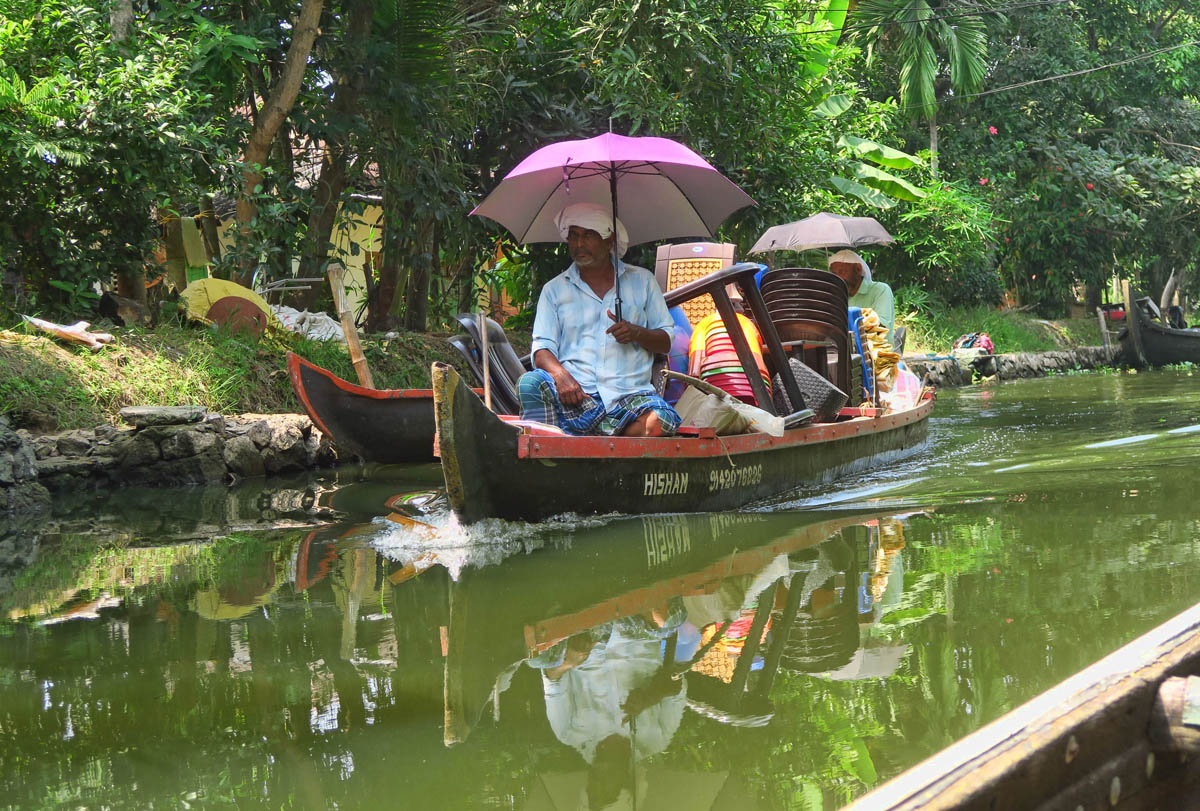
Believe it or not, these two guys are selling plastic furniture (note stacks of chairs and stools.) They shout out as they pass, beckoning prospective customers to the waterfront.
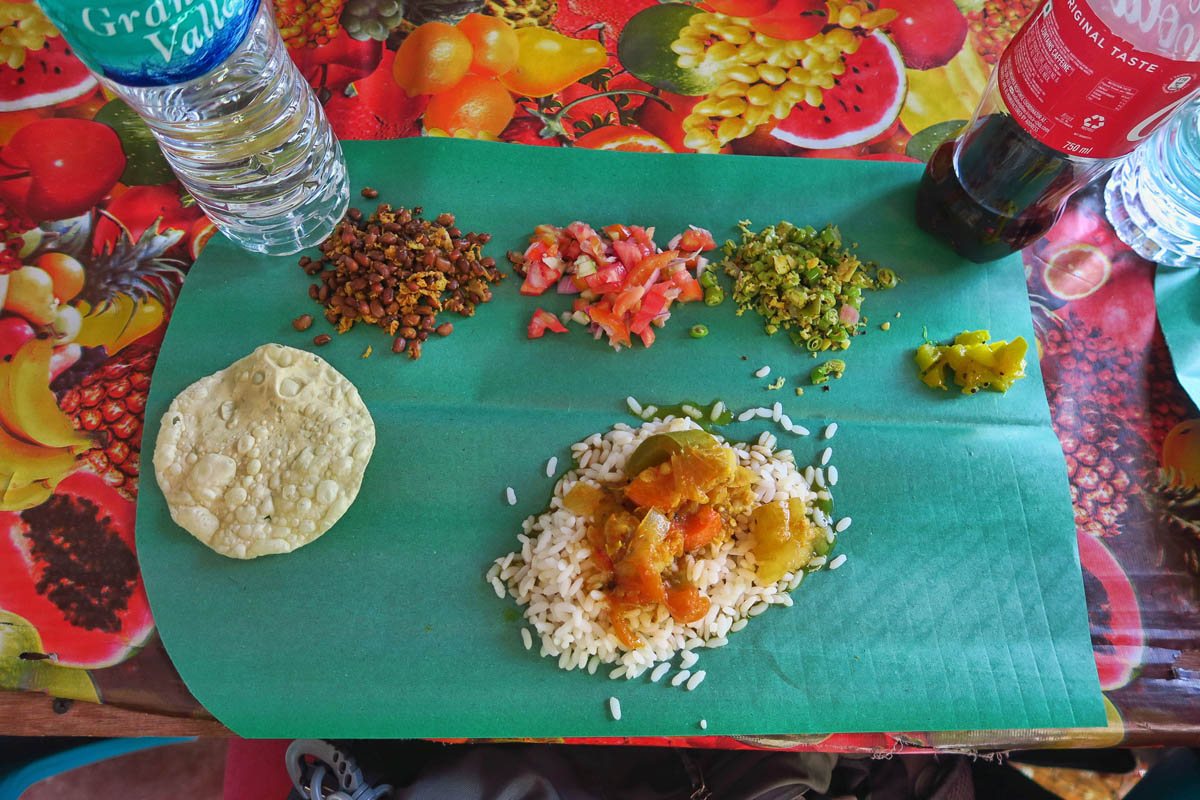
My day trip on the shikira boat included lunch. Gotta laugh at the “imitation banana leaf” plate! (Another “hands as utensils” dining experience.)
Anoop arranged both my day trip through the small villages in a shikara, as well as my overnight stay on a larger, one bedroom Kettuvallom. Not only did he confirm the bookings, but he drove me down to the dock on the back of his motorbike to introduce me to Captain Rubin and my own personal cook, “TikTok.” Anoop wanted to make sure the photos of the boat he had shown me were a true representation in exchange for the 7,000 rupees ($100, including three meals) I had paid for the overnight cruise.
While I thoroughly enjoyed my time cruising the Backwaters of Kerala, it didn’t take long to realize the impact tourism is having on this area. I was stunned when it was time to depart the dock, and it looked like 8:00am rush hour traffic. Leaving the canal headed for the lake, I counted twelve boats in front of us. Not exactly the serene, idyllic experience I had envisioned.
While my guidebook states there are around 500 houseboats to choose from in Alleppey, my boat captain tells me it’s now more like 1,500, a fact that causes me to feel a little twinge of guilt in hiring a boat, captain, and cook, all for my own boating pleasure. It’s a toss up on how one chooses to look at it. Am I part of the problem by feeding the demand? Or part of the solution by “feeding” the supply?
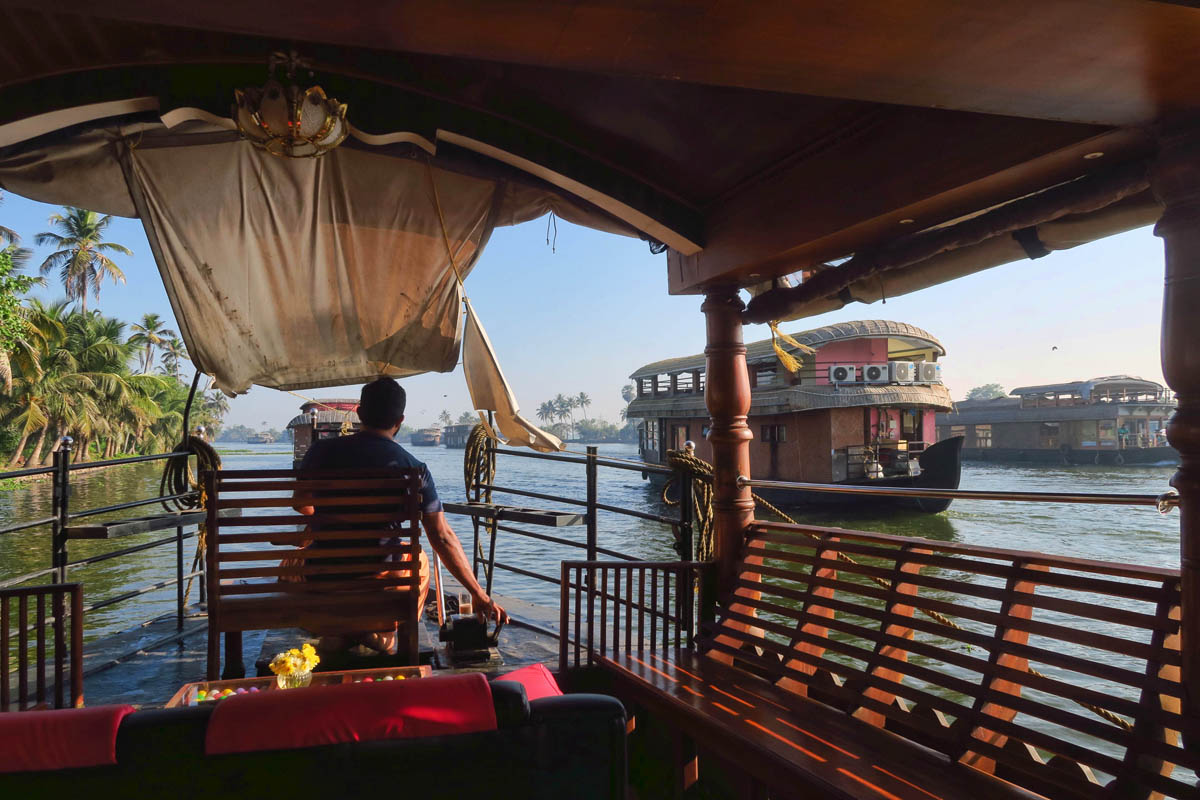
The lounge area of my one bedroom houseboat is outfitted with a couch where one can sit and watch the captain navigate through the waterways.
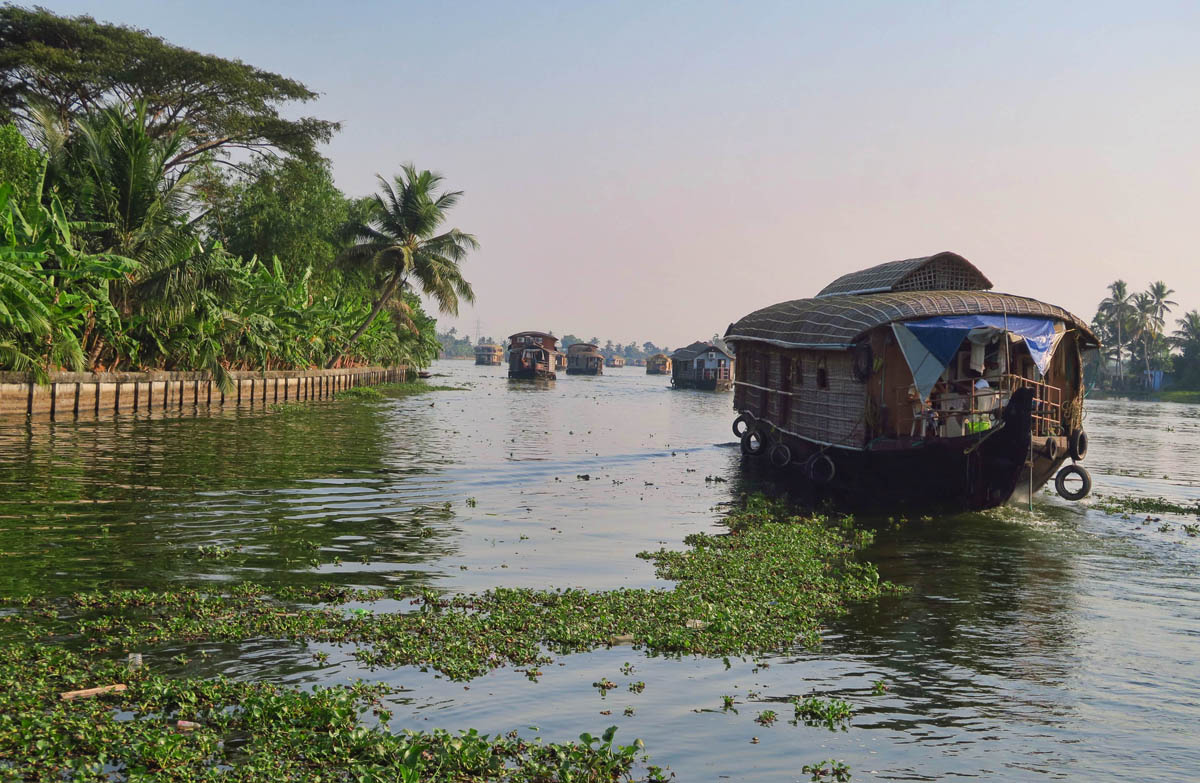
I count twelve boats in front of us and behind us.
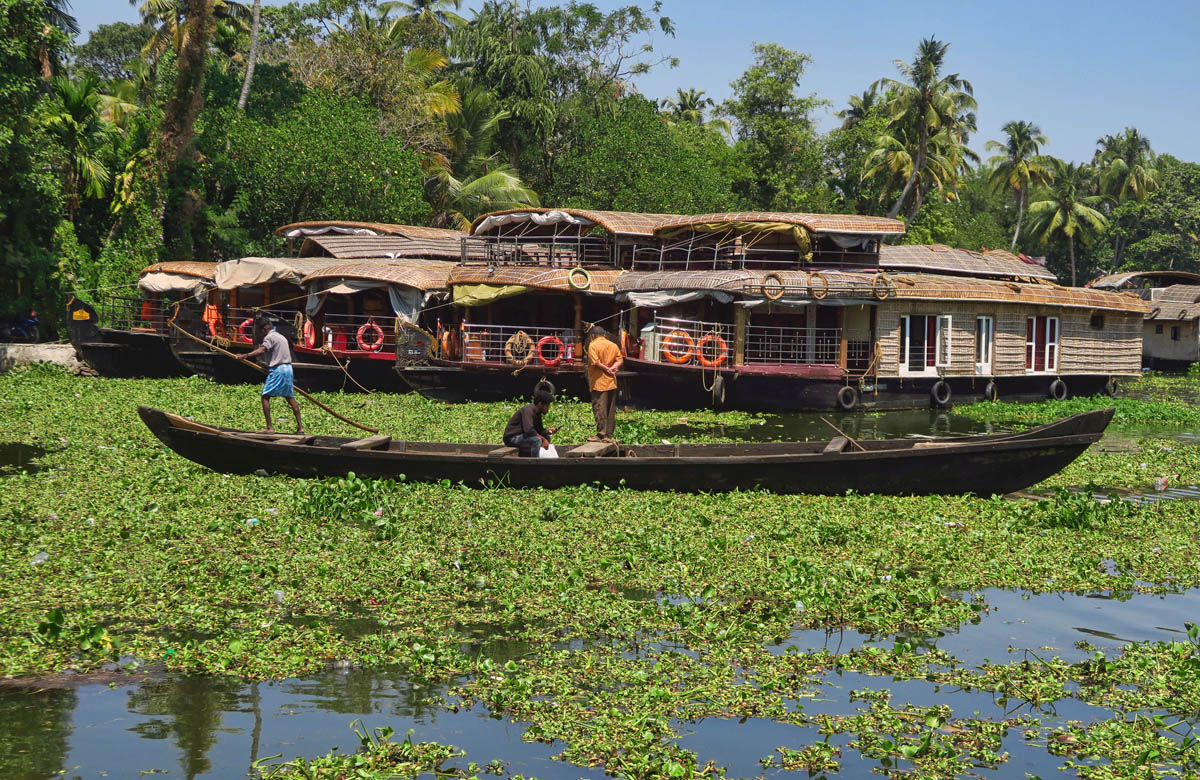
The waterways are very busy with lots to observe, though it can be a challenge to stay awake.

Here is my romantic bedroom for one, complete with heart-shaped ruffled pillows and towel peacocks. LOL!

The cook on board serves me some banana fritters and masala chai for afternoon break. “TikTok,” named for his hobby of the video app filmed on a tripod in his galley, is a young man of small stature who giggles every time I speak to him.
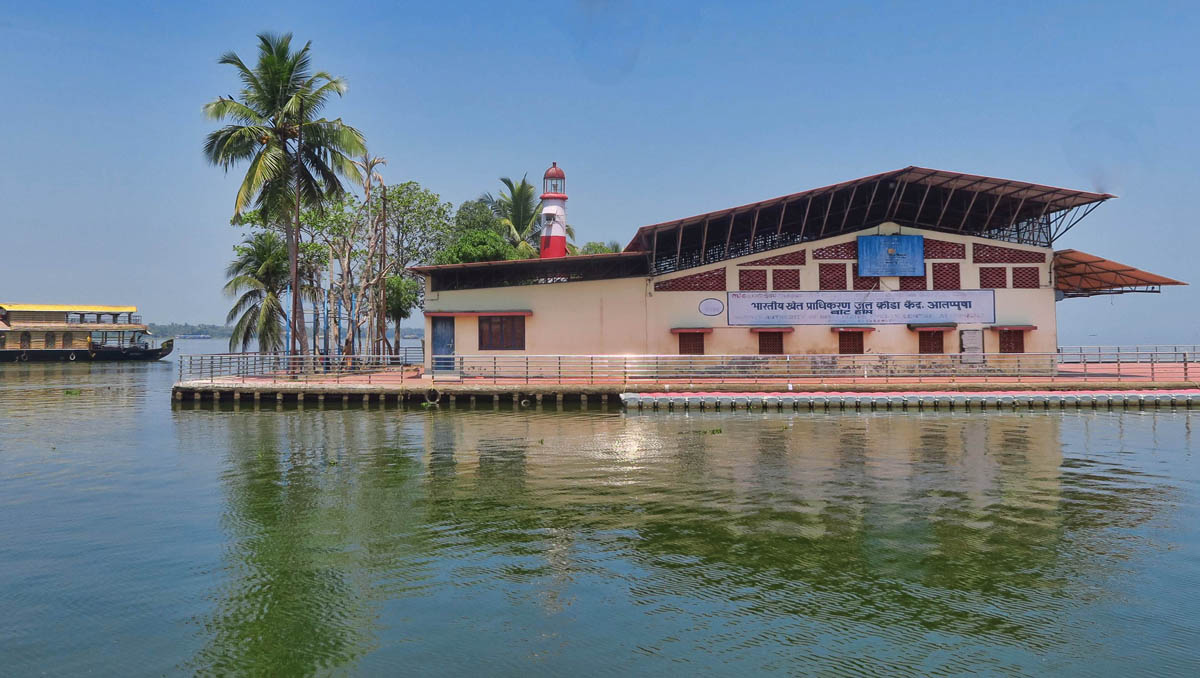
This lighthouse marks the point where the river meets India’s largest, but also longest lake.
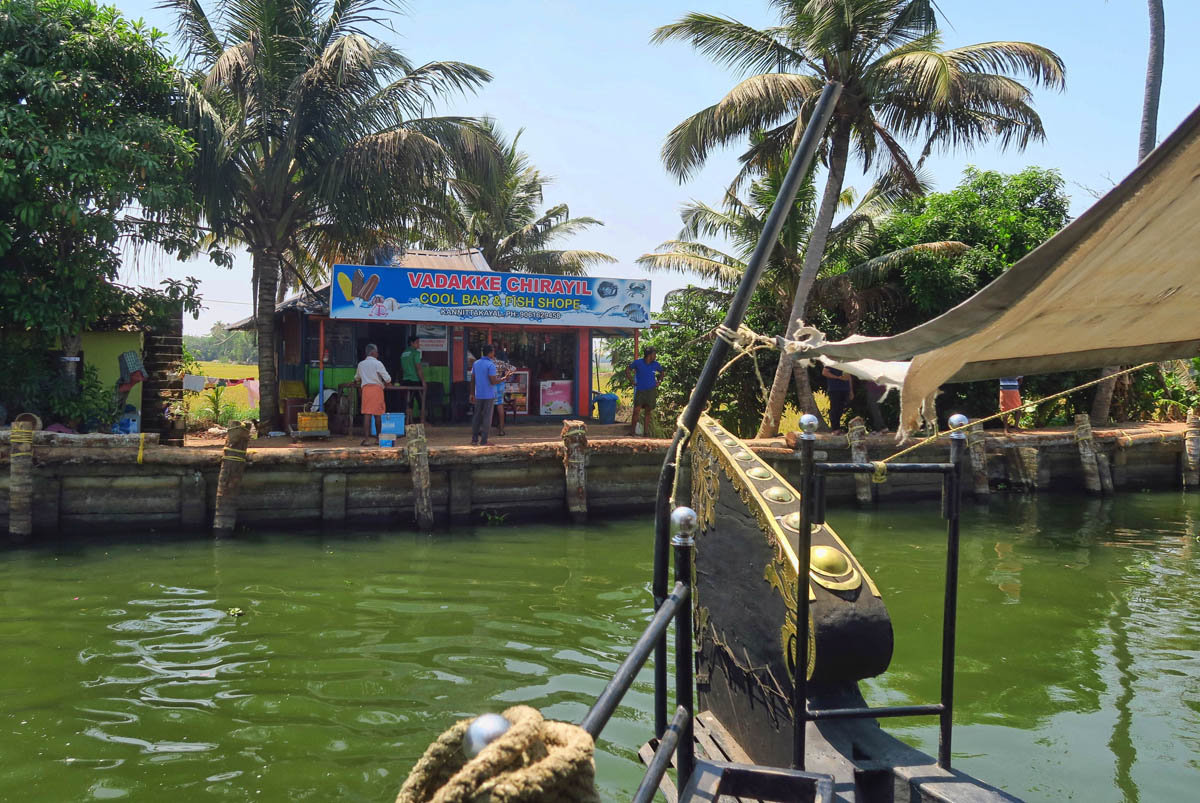
Meals are included in the houseboat cost, but we will also stop at a local seafood market in case I want to supplement the menu with some locally caught seafood.
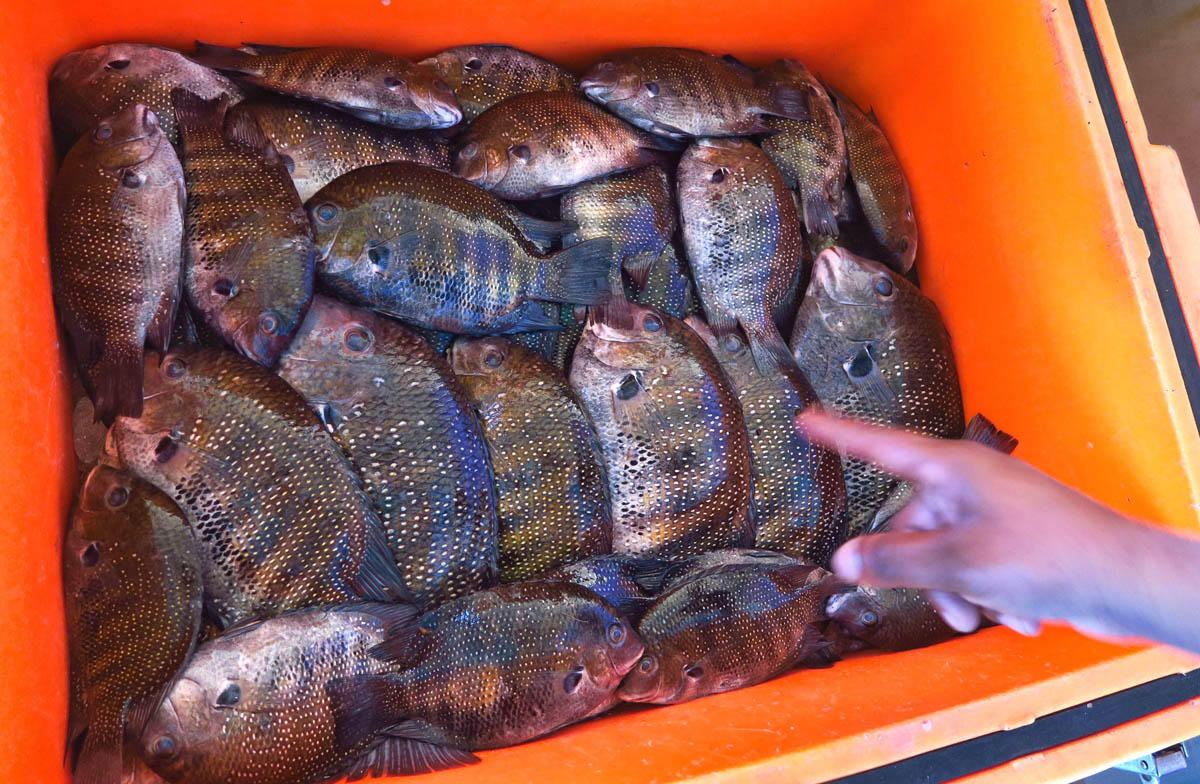
“Karimeen,” (also known as “Pearl spot” in English, named for the spot beneath its gill) panfried, is the local delicacy.

I opt to try the fresh water prawns which “Tiktok” will prepare for dinner.

Boat travel is a common way of life, as evidenced by the bridge structures.
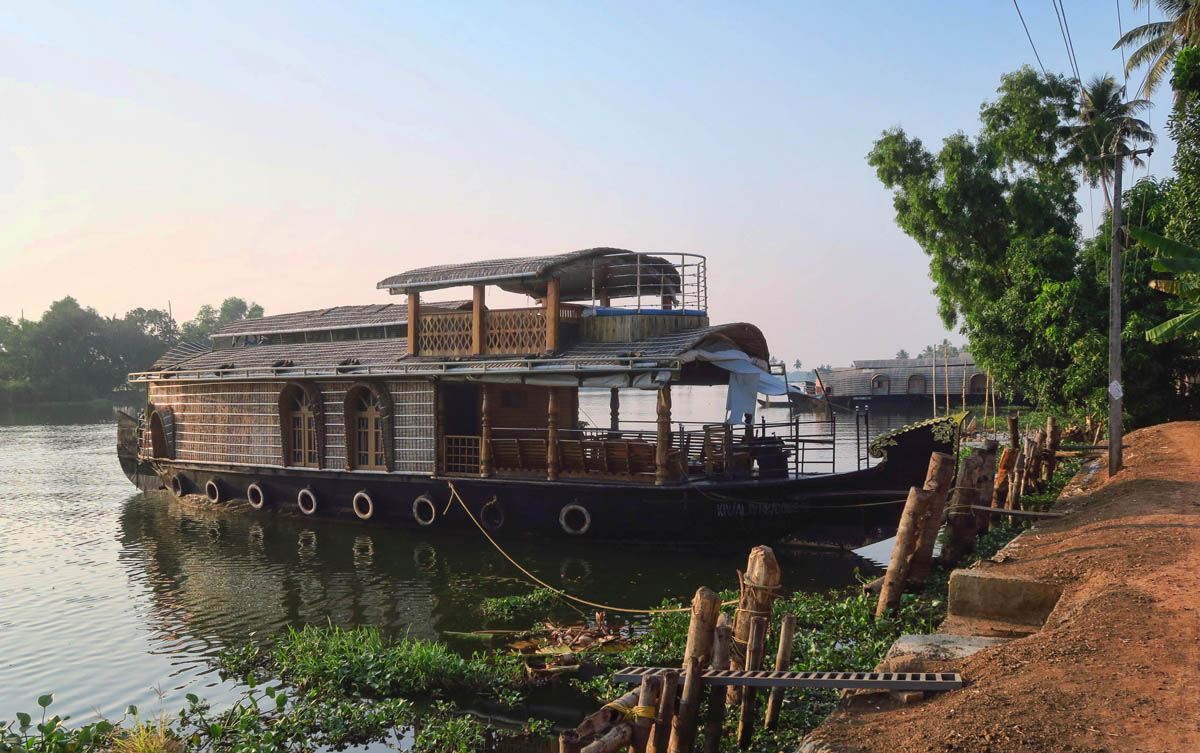
Most houseboats are equipped with AC in the bedrooms, as Kerala’s high heat and humidity would otherwise make sleeping impossible. However, it only runs from 9pm to 6am, because they must “plug in,” which consists of shoving two naked wires into an outlet on a light pole on shore.

Once the boat is docked, I get off for a walk along the levee and see fields of rice for miles in both directions.
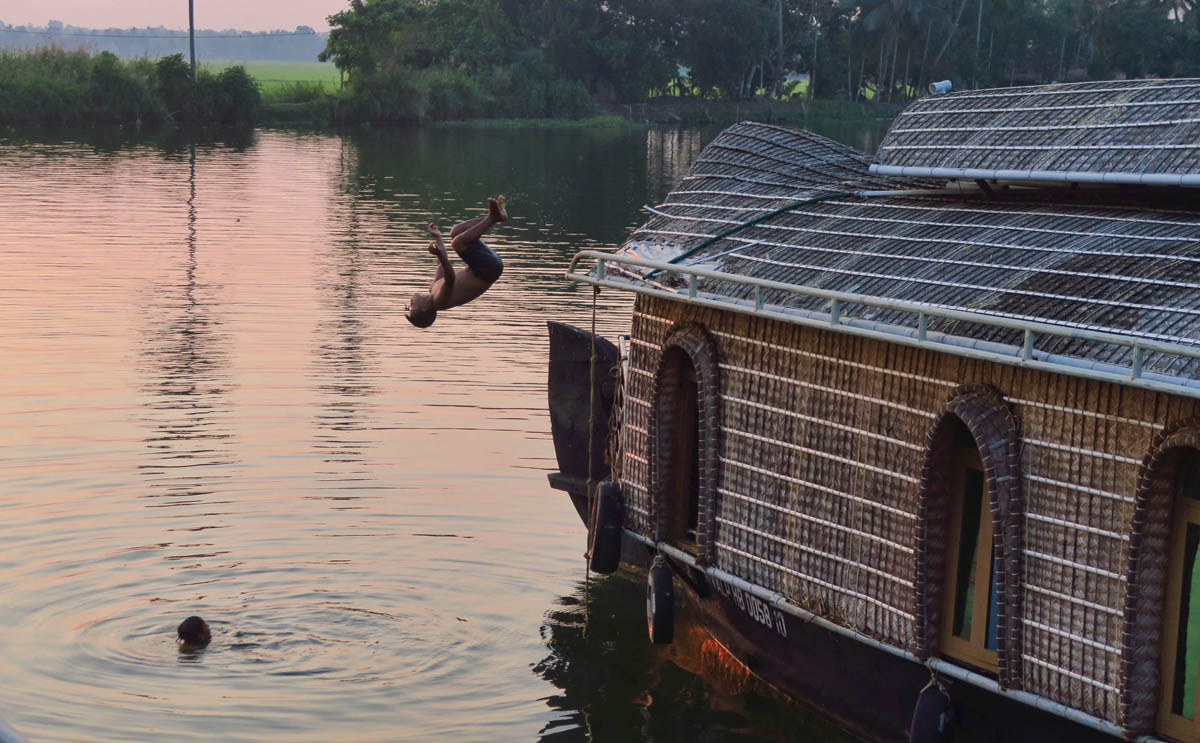
This is no isolated anchorage for houseboats, as boats line the shore to take advantage of the source of electricity. Boat crews all take a break for a quick dip before dinner.
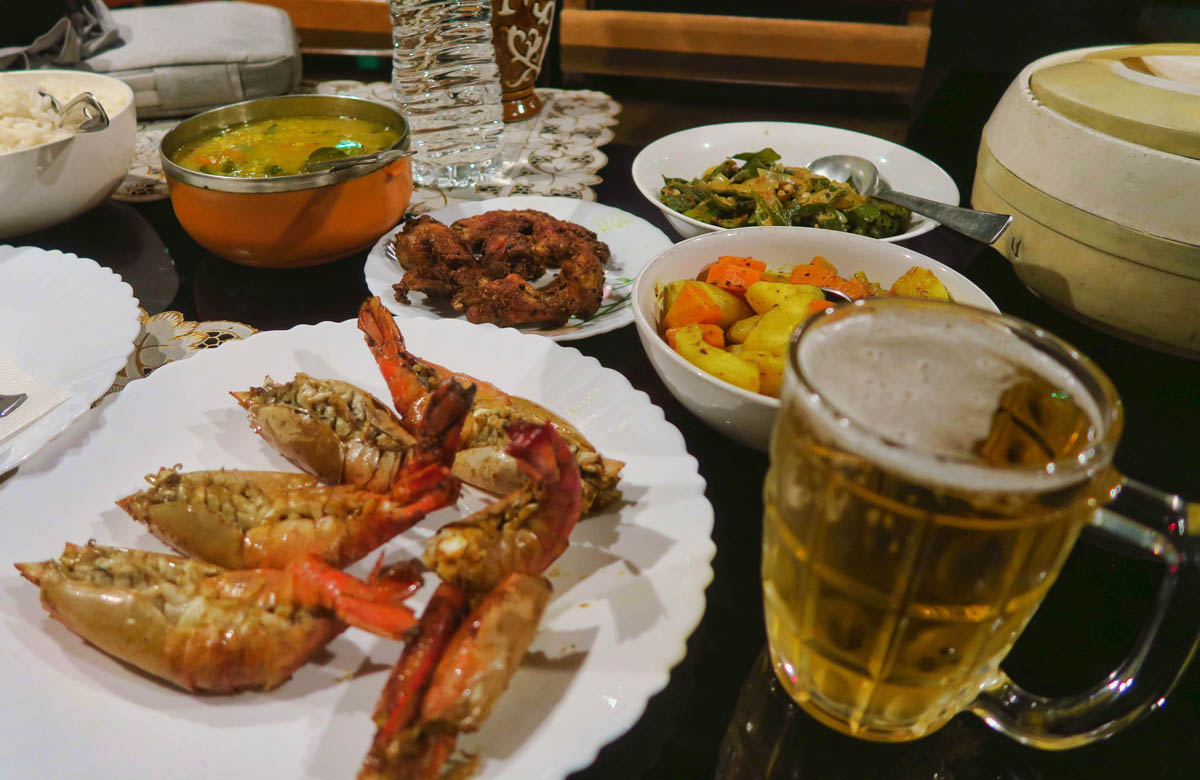
TikTok is an excellent cook, as I enjoy not only the fresh water prawns bought at the market earlier, but also lentil curry and rice, fried chicken nuggets, Bhindi Masala (okra, or “lady fingers” in masala spices) and root vegetables.
A recent environmental-impact assessment found that houseboat operations on Vembanad Lake have exceed its carrying capacity. Some signs of ecological responsibility are starting to emerge as the top of the line houseboats are converting to electric motors, but that’s a feature few can afford. Conservation attempts are underway by the government of India to protect Vembanad’s wetlands from houseboat motor pollution, dumping of raw sewage, and pesticide residue from paddy fields seeping into the backwaters causing dangerously high levels of heavy metals, all which threaten the fish life that sustains the villagers. May the circle be broken.
There have been times in my travels when looking back in hindsight, I feel a little sense of shame in having patronized a place. Maybe it’s a case of animals being used for bizarre forms of entertainment like swimming with the dolphins in Mexico, or visiting the Jumping Cat Monastery in Myanmar. Or places that are just trampled to death like Nepal’s Annapurna circuit where the path was literally paved with blue plastic water bottles. Places where visiting caused me to question my decision, or make me wish I had done a bit more research as to the sustainability. Backwater cruising was one of those times.
I have read several articles recently about how pollution is clearing up and the earth is getting a much needed rest through this time of COVID-ity. If one place needs such a rest, it is the backwaters of Kerala. It’s impossible to accept the loss of livelihood in a prosperous country such as ours during this unprecedented time, let alone an impoverished country like India. But at least if there is a silver lining to this impenetrable globe-enveloping COVID cloud, it’s that places like the canals of Alleppey and Vembanad Lake are getting a much needed break.

Sunset from the rooftop of the houseboat.
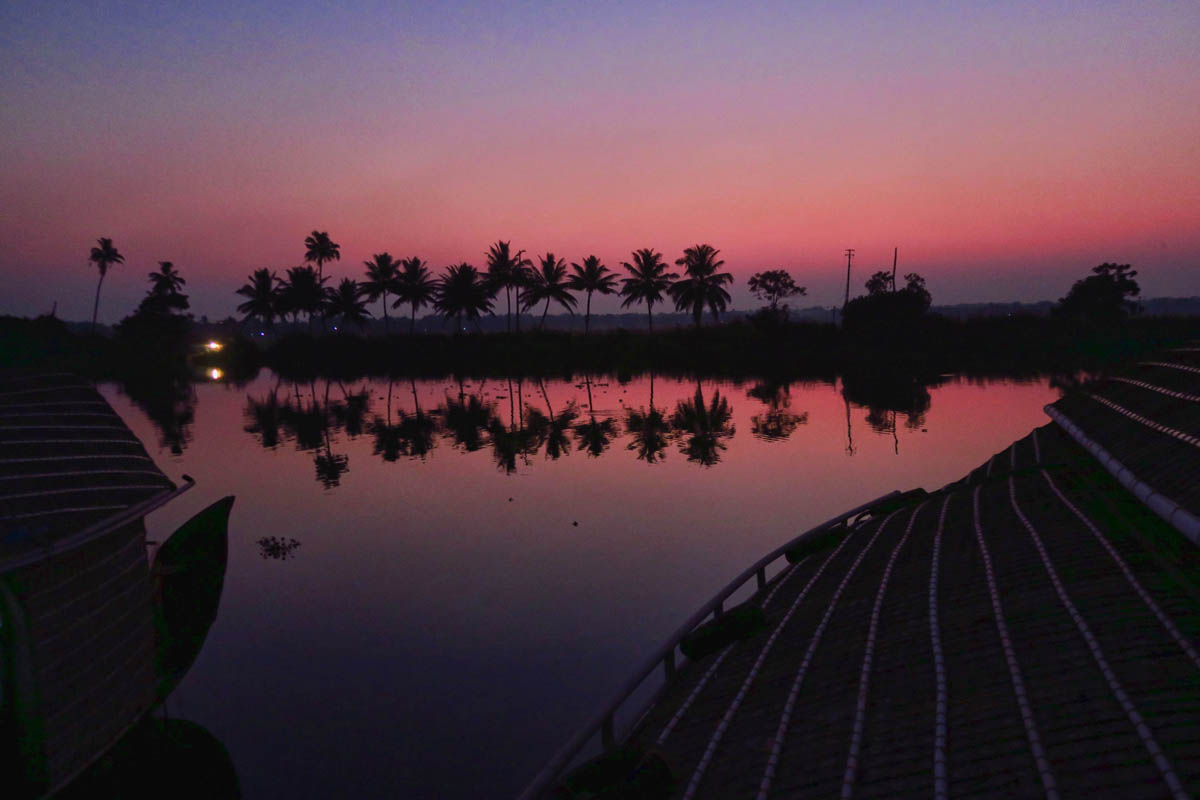
Your Moment of Zen

My moment of Zen indeed! so much to admire and ponder and marvel about . . . thank you Suzanne.
Great post and although I’ve not been to Kerala friends that have really enjoyed the experience.
Although you have mixed emotions about it, it looks like it was quite the experience! Those prawns looked delicious!
We planned tp stay on a houseboat on the lake in the mid 90’s. It was permanently tied up at a bird sanctuary that had been a rubber plantation. We were taken by boat from the reception area to the boat. We didn’t have a cook but they served us a late lunch in the open air lounge area. Just before sunset I went into the bedroom when I heard my husband exclaim. I asked him what was wrong and he didn’t want to tell me. He was sitting in a hanging chair and a rat had climbed down the chain! We grabbed our valuables and fled down the path through the bird sanctuary as it grew dark with my husband getting farther and father in front of me. The people at the reception area laughed at us and offered to spray to get rid of the rat! We ended up at the the hotel next door which was the plantation house. It had a restaurant with the best food we had in the months we were in India!
Another beautifully colored and richly sewn experience to witness through your eyes. Thank you, Suzanne! 🙂
Once again we are surprised and delighted by what you have shown and described for us. My bias about India are etching away as you show how diverse and beautiful a country it is. Thanks. I want those prawns.
I wonder(ed) how those “pet elephants” are treated, myself…..
The water hyacinths reminded me of our Kudzu and how that stuff will just choke out the entire lake. Ugh. Hope they find a way to contain it.
Are there alligators/crocs in that water? Monkeys in the trees overhead?
I guess I could Googer it, but I know you’ve missed my questions lately, right? Right? 🙂
Oh, how I love your questions, My Dear Cousin. Even when I don’t have answers, you make me want to be a better reporter. LOL! No alligators or monkeys there, (though monkeys will be starring in one of my upcoming posts.) I am not sure why there are no gators or crocs, as I know they exist in India, but there are none in the backwaters. Maybe the water is too brackish? More likely too polluted. 😮
As for the elephants, I did ask that question, as like you, the “jewelry” (chains) around their ankles gave me pause. But I learned that they are rented by the temples during festival season, just as one might rent a pony for a party. The rest of the time, they live on “ranches” like a horse farm. While it’s still cringe-worthy (after all, how do they get “trained?”) I felt better thinking they might have a little free time to roam…
Hope you and Jeffy-poo are staying sane! xxx
One branch of my family lived in this area about five generations back. I can only imagine what it must have been like in those days. We never heard stories about canal boat life.
Your environmental concerns are very real from my viewpoint however you have been a window to this area for many potential travelers with your very complete posts. Feel good about that, so much to see in this complicated world.